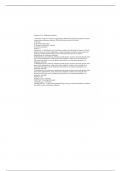Exemplar 16.11 Pulmonary Embolism
1) The nurse caring for a client recovering from an abdominal hysterectomy suspects the client is
experiencing a pulmonary embolism. What did the nurse assess in this client?
A) Nausea
B) Decreased urine output
C) Dyspnea and shortness of breath
D) Activity intolerance
Answer: C
Explanation: A) Manifestations of a pulmonary embolism include dyspnea, shortness of breath,
pleuritic chest pain, anxiety, apprehension, cough, tachycardia, tachypnea, crackles, and a low-
grade fever. Decreased urine output, activity intolerance and nausea are not clinical
manifestations of a pulmonary embolism.
B) Manifestations of a pulmonary embolism include dyspnea, shortness of breath, pleuritic chest
pain, anxiety, apprehension, cough, tachycardia, tachypnea, crackles, and a low-grade fever.
Decreased urine output, activity intolerance and nausea are not clinical manifestations of a
pulmonary embolism.
C) Manifestations of a pulmonary embolism include dyspnea, shortness of breath, pleuritic chest
pain, anxiety, apprehension, cough, tachycardia, tachypnea, crackles, and a low-grade fever.
Decreased urine output, activity intolerance and nausea are not clinical manifestations of a
pulmonary embolism.
D) Manifestations of a pulmonary embolism include dyspnea, shortness of breath, pleuritic chest
pain, anxiety, apprehension, cough, tachycardia, tachypnea, crackles, and a low-grade fever.
Decreased urine output, activity intolerance and nausea are not clinical manifestations of a
pulmonary embolism.
Page Ref: 1212
Cognitive Level: Analyzing
Client Need: Physiological Integrity
Nursing Process: Assessment
Learning Outcome: 1. Describe the pathophysiology, etiology, clinical manifestations, and direct
and indirect causes of pulmonary embolism.
, 2) The nurse is concerned that a client admitted for a total hip replacement is at risk for thrombus
formation. What assessment information caused the nurse to come to this conclusion?
A) Body mass index (BMI) 35.8
B) Former cigarette smoker
C) Blood pressure 132/88 mmHg
D) Age 45 years
Answer: A
Explanation: A) Risk factors for the development of thrombus formation that could lead to a
pulmonary embolism include obesity, orthopedic surgery, myocardial infarction, heart failure,
and advancing age. The BMI of 35.8 falls into the category of obese, which would increase the
client's risk of developing a thrombus and possible pulmonary embolism. The client's age, status
as a former smoker, and blood pressure would not have as significant an impact on the
development of a thrombus as the client's weight.
B) Risk factors for the development of thrombus formation that could lead to a pulmonary
embolism include obesity, orthopedic surgery, myocardial infarction, heart failure, and advancing
age. The BMI of 35.8 falls into the category of obese, which would increase the client's risk of
developing a thrombus and possible pulmonary embolism. The client's age, status as a former
smoker, and blood pressure would not have as significant an impact on the development of a
thrombus as the client's weight.
C) Risk factors for the development of thrombus formation that could lead to a pulmonary
embolism include obesity, orthopedic surgery, myocardial infarction, heart failure, and advancing
age. The BMI of 35.8 falls into the category of obese, which would increase the client's risk of
developing a thrombus and possible pulmonary embolism. The client's age, status as a former
smoker, and blood pressure would not have as significant an impact on the development of a
thrombus as the client's weight.
D) Risk factors for the development of thrombus formation that could lead to a pulmonary
embolism include obesity, orthopedic surgery, myocardial infarction, heart failure, and advancing
age. The BMI of 35.8 falls into the category of obese, which would increase the client's risk of
developing a thrombus and possible pulmonary embolism. The client's age, status as a former
smoker, and blood pressure would not have as significant an impact on the development of a
thrombus as the client's weight.
Page Ref: 1212
Cognitive Level: Analyzing
Client Need: Physiological Integrity
Nursing Process: Assessment
Learning Outcome: 2. Identify risk factors and prevention methods associated with pulmonary
embolism.




